
October 2003
140 Dead – President Flees
as Miners Pour Into La Paz
Vice President Takes Over
Due to Union Tops’ Sellout
Bolivian
Workers Uprising Knifed,
Workers Still on Battle Footing
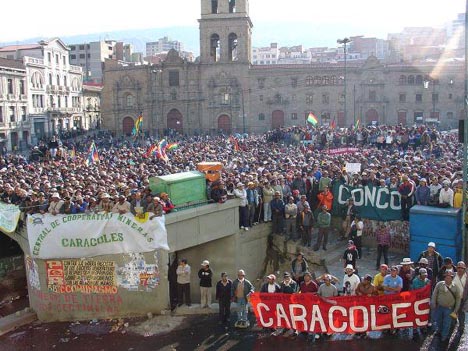
Plaza de
San Francisco in La Paz overflows on October 17, full of miners
and other workers demanding the resignation of President Sánchez de Lozada.
(Photo: Sebastian Hacher/Indymedia Bolivia)
- The Central Slogan Remains: Workers to Power!
- Build the Nucleus of a Genuine Trotskyist Bolshevik Party!
OCTOBER 26 – After weeks of massive and increasingly combative mobilizations, on October 17 Bolivian president Gonzalo Sánchez de Lozada fled the country, leaving his vice president Carlos Mesa in power. What set off the conflict was “Goni’s” plan to carry out a new looting of Bolivia’s natural resources through a sweetheart contract with a consortium of imperialist companies. In order to please his masters in Washington, the murderous president drenched the country in blood, with a toll of 140 dead and some 500 injured, according to the figures of the Central Obrera Boliviana (COB – Bolivian Labor Federation). The repression was coordinated with U.S. military commanders. Furious demonstrators wrote on the walls in the center of La Paz, “Goni, either you go or we’ll kill you.” The next day, San Francisco Plaza in the Bolivian capital was filled with tens of thousands of workers and peasants celebrating the departure of the bloody tyrant.
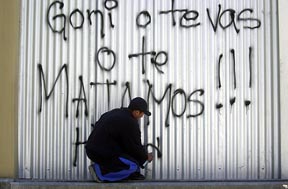 “Goni, either you go or we’ll kill you.” Demonstrator in La Paz paints his
dramatic message, October 16. The next day the murderous president left.
“Goni, either you go or we’ll kill you.” Demonstrator in La Paz paints his
dramatic message, October 16. The next day the murderous president left.
(Photo: Nacho Calonge/AP)
It was the miners who were decisive in forcing the flight of Sánchez de Lozada. When they managed to pass the military barrier at Patacamaya – where three of their comrades were killed by the army – the president’s last day had begun. His fate was sealed with the arrival of more than 10,000 miners in the center of La Paz on the morning of Friday, October 17. In the city of El Alto, the poorest city on the continent with some 600,000 inhabitants, demonstrators were constantly chanting for “civil war.” Yet by granting an “intermission” to “Goni’s” successor, the leaders of the COB, together with those of the Movement for Socialism (MAS) and the Indian movement, betrayed the workers who fought so heroically against the puppet regime in the “gas war.” They stabbed the burgeoning workers uprising in the back; in reality, they feared it as much as the bourgeoisie did.
Many fake leftists are hailing the
“victory,” but toppling the hated president and replacing him with his anointed
successor is hardly a victory. The League for the Fourth International, in
contrast, denounces the betrayal by the misleaders of the workers
and peasants – including those who claim to be revolutionaries – in granting
a “truce” to the new president. Mesa is a puppet of the armed forces and
imperialism, who has the backing of the White House, the International Monetary
Fund and the World Bank. We warn that the new president is wedded to the
same program of privatization, poverty and pillaging of the country by the
“multinationals” as his godfather Sánchez de Lozada. But the final
outcome is yet to be determined. The workers are still on the alert, ready
to mobilize again. We stress that the central demand continues to be: Workers
to power! The urgent task is still the construction of the nucleus
of a genuinely Trotskyist Bolshevik party.
In the confrontation at Patacamaya,
where the army dispatched two tanks and a plane against the crowd, the military
finally let the marchers pass after several thousand miners managed to get
around the blockade. Together with university students from Oruro, the marchers
headed to La Paz where they joined with thousands of workers, peasants,
students and residents of poor neighborhoods in the midst of a general strike
which brought the country to a halt. Radio stations broadcast the position
of the residents of El Alto: “anyone who engages in dialogue is betraying,
the moment to take power has arrived” (Pulso, 17 October). With a
heavy presence of workers and Aymara Indian peasants, El Alto was the epicenter
of the uprising. According to journalists’ reports, the Federation of Neighborhood
Committees (FEJUVE) pointed to the need to set up self-defense groups against
the onslaught of repression.
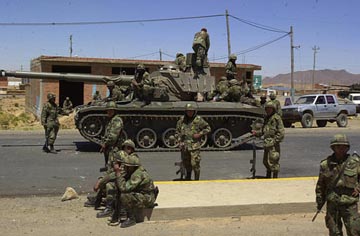 Patacamaya,
October 16. The beginning of the end for “Goni” came when miners managed to
get around the military blockade (see photo) to arrive in the capital. (Photo:
Nacho Calonge/AP)
Patacamaya,
October 16. The beginning of the end for “Goni” came when miners managed to
get around the military blockade (see photo) to arrive in the capital. (Photo:
Nacho Calonge/AP)
In the face of this increasing radicalization,
the American proconsul David Greenlee issued his verdict: “The time has
come to turn the page.” The new “leader” appointed a “non-political” cabinet
filled with technocrats, people of “spotless” reputation. In reality, this
cabinet without politicians is a façade to hide the decisive power
which is in the hands of the military. The military and police high command
has not been touched. The minister of defense is a general, and the minister
of agriculture is one of the big soy exporters. The commitments to the IMF
are to be carried out to the letter. Congress remains in the hands of the
coalition of Sánchez de Lozada. The new government is precisely “Gonism
without Goni.”
This ruling-class Operation Rescue
is having success for the moment due to the absence of a revolutionary leadership
and the betrayal of the reformist and nationalist leaders who still remain
at the head of the mass organizations of the working people.
The maneuver by the domestic bourgeoisie and imperialism received the backing of the “opposition” parties. In the first instance, this means the MAS, headed by Evo Morales, leader of the coca-growing peasants, and the Pachacuti Indian Movement (MIP) headed by his rival in the peasant movement, Felipe Quispe. Morales declared: “We will give a breathing space to President Carlos Mesa, a truce, so that he can organize and carry out his promises to the country.” Quispe, who is known as “El Mallku,” said, “We will be vigilant so that the necessary economic and political changes can be carried out,” and he even joined Mesa during a peasant demonstration in La Paz on October 20.
It was the same story with the workers leaders. Following the departure of “Goni” and with his vice president now installed in the presidential palace (the Palacio Quemado), the union leaders gave him their support: “We have indicated that Mesa will have our backing as long as he energetically fights corruption,” said the executive secretary of the COB, Jaime Solares, following a personal visit with Mesa on Saturday, October 18. This will allow Sánchez de Lozada’s deputy to continue in power simply by carrying out a minimal “investigation” of the millions that “Goni” and his defense minister, Carlos Sánchez Berzaín, carried off with them. But Solares didn’t simply give after-the-fact support to a fait accompli. Even before Congress opened its session and Mesa assumed the presidency, the latter called Solares to ask for “guarantees,” and the head of the COB gave them.
The sell-out leaders admit it themselves.
According to an article from Econoticias Bolivia (19 October) on the COB
Expanded National Plenum held the previous day, “they drew one main conclusion:
the workers, peasants, oppressed nations and impoverished middle classes
did not rip power from the hands of the ‘ruling class’ because they still
‘don’t have’ a ‘revolutionary party’.” In the meeting, COB leader Solares
recognized that “no leader and no political party led this popular uprising….
This struggle, unfortunately, did not have a unified leadership. The Bolivian
workers, from below, were the ones who kicked the murderer ‘Goni’ out of
power.”
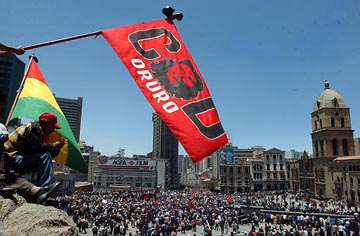 Mass demonstration
in La Paz, October 16. The enormous power of the working masses was betrayed
by reformist and nationalist misleaders. (Photo: Jorge Sáez/AP)
Mass demonstration
in La Paz, October 16. The enormous power of the working masses was betrayed
by reformist and nationalist misleaders. (Photo: Jorge Sáez/AP)
Miners’ leader Miguel Zuvieta admitted, “No union and no left party
imagined the magnitude of the conflict that was approaching…. The massacre
of El Alto (October 12) was the detonator that set off the war against the
government and imperialism. From that point on, the conflict got out of our
hands. It was uncontrollable.” So finding that they could not control or contain
the explosion of fury by the working masses, the leaders decided to call
off the indefinite general strike, take down the highway blockades and give
Mesa a deadline of 90 days. The leader of the Oruro Departmental Labor Federation
(COD), David Rojas, spoke of “waiting for the results of the new president’s
administration” (La Patria [Oruro], 19 October).
For its part, the Bolivian “Communist”
Party, which has carried out a thousand Stalinist betrayals, calls on Mesa
to adopt an emergency plan, warning that its absence “is a threat to the
stability of the new government,” which is being “questioned by ultra-leftist
and radical sectors who irresponsibly believe that the moment has arrived
for revolutionary change” (PCB communiqué, 22 October).
One of the most popular leaders, who
enjoys almost unanimous support on the “left,” is Roberto de la Cruz of
the El Alto COR, the union body whose militancy reflects the presence in
the city of many ex-miners who were “resettled” due to the closure of the
state-owned mines by the hated Decree 21060. Following Sánchez de
Lozada’s flight, De la Cruz announced: “This is the triumph of the poor,
of the workers and of the peasants.” During the October 18 rally in the
Plaza San Francisco, the El Alto workers leader called on the working people
“to solemnly swear not to betray the Bolivian social movement and to unstintingly
fight until the poor come to power,” as El Diario (19 October) reported.
Yet the leaders, including him, had already sold out the struggle
of the working people. “For his part,” the paper reported, “the executive
secretary of the Central Obrera Regional of El Alto, Roberto de la Cruz,
said that he would grant the new head of state some time so that he can organize
his cabinet and get negotiations going again on labor’s demands.”
De la Cruz later hardened his rhetoric
against the Mesa government, although he directed his attacks mainly at
Mesa’s ministers and advisers. At the same time, he has been pushing anti-Chilean
poison, reflecting the worst aspects of bourgeois nationalism, which has
characterized above all the discourse of the MAS during the “gas war.”
Thus the leader of the El Alto COR says of the new president that “we know
he is surrounded by a pro-Chilean clique.”
After the El Alto massacre, the COR
put out a “Message of Instructions to the Courageous Fighters of the City
of El Alto, who resist the Sánchez de Lozada government that toadies
to imperialism,” under the title: “We Will Not Stop Until We Bring Down
the Murderous Fascist Government.” But in spite of the bombastic language,
it ends up calling on the city council members of El Alto, governed by the
MIR (Revolutionary Left Movement, which originated as a “moderate” left
party and later allied itself with the dictator Hugo Banzer), to “identify
with the popular movement of the working people,” and calls on the “police
intelligence services to protect the interests of the people of Bolivia.”
Calling on the police butchers to
defend “the interests of the people” is sowing suicidal illusions. Many
left groups have encouraged illusions in the role of the police in Bolivia,
both last February and today. But showing a white flag and letting demonstrators
through is hardly the same as going over to the insurrectionary masses,
as the opportunists pretend. The police are professionals of repression,
specializing in attacks on the workers. In the case of the army, we have
called for the formation of councils of the worker and peasant conscript
soldiers against their bourgeois officers. In contrast to the pseudo-leftists,
revolutionaries tell the truth, that the police and military officialdom
are the armed fist of the bourgeoisie, the backbone of the capitalist state.
The claim by the union, peasant and
“opposition” party leaders that they are only making a tactical retreat
is false. At the crucial movement they supported the bourgeoisie’s
substitute team. They openly proclaim their class collaboration with
Goni’s man, who has rightly been called a “cachorro de la burguesía”
(running dog of the bourgeoisie) and who represents the same policies and
the same capitalist class. After proclaiming they didn’t want the same regime
“in new skirts,” that is exactly what they are backing. It is not for
this that some 140 workers and peasants gave their lives, it is not for this
that more than 500 working people, youth and residents of poor neighborhoods
were wounded
One of the most notable aspects of
recent days has been the effort by the Bolivian bourgeoisie and its imperialist
masters to channel the masses’ anger into a phony “democratic” way out of
the crisis. In this, they have been able to count on the aid of almost the
entire spectrum of the opportunist left, from the “opposition” benches in
parliament to the supposed far left, including those who proclaim themselves
Trotskyists.
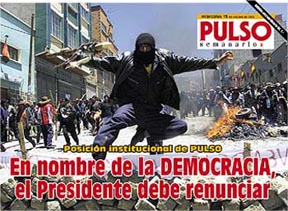 Even liberal sectors
joined in demanding the resignation of “Goni” (see cover of the extra
edition of the weekly Pulso), presenting the issue as if it is one
of (bourgeois) democracy. Marxists fight for a revolutionary class
program.
Even liberal sectors
joined in demanding the resignation of “Goni” (see cover of the extra
edition of the weekly Pulso), presenting the issue as if it is one
of (bourgeois) democracy. Marxists fight for a revolutionary class
program.
For some time now, Evo Morales’ MAS
has been urging the calling of a constituent assembly to “refound the country”
with a new constitution. Tailing after it are several left organizations,
including the small Liga Obrera Revolucionaria – Cuarta Internacional, affiliated
with the Fracción Trotskista headed by the Argentine PTS (Socialist
Workers Party). The LOR-CI’s programmatic calling card has been the demand
for a constituent assembly, to which they tack on the adjective “revolutionary.”
But there is nothing revolutionary about this policy, and it is grossly
tailist. In a supplement to their paper Lucha Obrera (29 September)
they write: “The MAS and Evo Morales have spoken on several occasions of
a Constituent Assembly. Now is the time to go from words to deeds and to
raise this as part of their action program, because now is when it is necessary
to fight to impose this!” In this way, just like the openly reformist outfits,
the LOR-CI presents the issue as if it were basically a democratic
question.
Now the new president Carlos Mesa has
taken up the demand for a constituent assembly. In his inaugural address
as president, he promised to “refound” the country by calling a constituent
assembly. In this he can count on the enthusiastic support of the World Bank,
no less. This cartel of bloodsucking imperialist bankers declared: “In order
to protect investments, social peace is necessary; obviously we think that
the dialogue that will take place in conjunction with the referendum [on
the sale of gas] and the constituent assembly will help” (Bolpress, 22 October).
As we wrote concerning the constituent assembly in our article, “Bolivia
Aflame: Gas War on the Altiplano, Workers to Power!” (14 October), “In the
mouths of bourgeois and petty-bourgeois politicians, this slogan is a means
of preventing the struggle from escaping the bounds of capitalist ‘democracy’;
coming from leftist groups, it is a policy intended to evade the need to
really fight for workers revolution, a kind of ‘minimum program’.”
Jaime Solares and other COB leaders
brandish the threat that if the Mesa government doesn’t deliver the goods
to their satisfaction, they could call a “People’s Assembly.” Since 1971,
when the Asamblea Popular was established in the shadow of General Juan
José Torres, reestablishing this body has been the great dream of
the main pseudo-Trotskyist organization in Bolivia, Guillermo Lora’s Partido
Obrero Revolucionario (POR – Revolutionary Workers Party). In reality, that
assembly tied the workers to bourgeois sectors and its incapacity to organize
resistance to General Banzer’s coup was followed by the formation of a popular
front in exile with the very same General Torres.
Neither a Constituent Assembly nor
a People’s Assembly, but the Bolshevik program of power to the workers, peasants
and soldiers councils, like the soviets which took power in the Russian
Revolution of October 1917: this must be the program of genuine revolutionaries
in Bolivia today. In the months leading up to the October Revolution, the
opportunist parties told the peasants that a “constituent assembly” would
grant them land and would put an end to the imperialist war. The Bolshevik
Party led by V.I. Lenin and Leon Trotsky urged them to seize the land with
their own hands. To the workers and soldiers they said that they, together
with their peasant brothers, should take all the power, extending the revolution
to neighboring countries and to the powerful proletariat of the imperialist
countries.
In Bolivia, ever since colonial times
the indigenous peoples have been subjected to brutal oppression and exclusion.
In this country, where since the rebellion of Túpac Katari in 1781
the bourgeoisie has lived in fear of the spectre of an Indian siege of La
Paz, we call to fight for a worker-peasant-Indian government, that
would be the dictatorship of the proletariat against the dictatorship of
capital. We emphasize that the foundation of the revolutionary program is
proletarian internationalism, which is the opposite of the anti-Chilean nationalism
which only places obstacles in the way of the necessary unity with the workers
of Chile, Peru and all of Latin America. A workers revolution in Bolivia
would have to be extended to the entire region, seeking to form an Andean
federation of workers republics, as part of a Socialist United States
of Latin America. It is crucial that it extend as well to the proletariat
of the United States in a struggle that would defeat imperialism and all
of its “running dogs” in the semi-colonies once and for all.
Despite the “truce” decreed by the
tops, in the ranks the struggle continues. The peasants have seized the lands
of the Sánchez de Lozada family. The slogan has been raised to occupy
“Goni’s” mines, and that the miners themselves should impose the expropriation
of all the mines and workers control of production. In the Chapare region,
repression continues against peasants who are demanding freedom to cultivate
and sell coca and who oppose imperialist programs for eradicating the crops.
It has been reported that when the Bolivian president visited the White
House a year ago, he told President Bush that if he continued this eradication
program, “I may be back here in a year, this time seeking political asylum”
(New York Times, 23 October). And that turned out to be true.
We defend the struggle of the coca-growing
peasants in Bolivia, where the use of the coca leaf has been traditional
since time immemorial. We stress that in order to break the stranglehold
of Yankee imperialism it is necessary to confront the “war on drugs” unleashed
by Washington. In reality, this is a war against the oppressed masses of
Latin America and against the black ghettos and Latino barrios in the United
States. Marxists oppose the outlawing or penalization of drugs (just as we
also oppose laws against alcohol).
In the course of the mobilizations,
many undeniably important demands have been raised, among them the call
for repeal of Decree 21060 and the Oil and Gas Law; imperialist troops and
advisors out; for a living minimum wage with a cost-of-living escalator
to compensate for inflation; immediate cancellation of all arrest warrants,
and other demands as well. In order to fight for these demands, it is fundamental
to put forward a strategy and perspective of permanent revolution,
for consistent class struggle capable of wrenching the urgent needs of the
working masses from the grip of the ruling class.
At every decisive turn of the class
struggle, the sellout leaders have turned power over to the bourgeoisie.
This was the case in April 1952, when Juan Lechín and his followers
handed power on a platter to Víctor Paz Estenssoro and Hernán
Siles Zuazo of the MNR (Revolutionary Nationalist Movement). This was the
case in 1970-71, when the Comando Político of the COB acted as an
adjutant for General Torres. This was what happened in 1982 when the military
dictatorship fell and a bourgeois popular front of Siles Zuazo, Jaime Paz
Zamora and the PCB was brought in. That government paved the way for the
return of MNR chief Paz Estenssoro so that he could close the mines and throw
thousands of miners out of their jobs. And so it is today, when Solares and
the COB hand power to Mesa, with the approval of the MAS, the MIP and the
rest of the “opposition” parties.
It is necessary to draw the political
lessons from this history in order to use them in forging the nucleus of
a new leadership that measures up to the enormous heroism and will to struggle
of the Bolivian workers. “When you have problems, just call us,” said a
miner from Huanuni as he left La Paz (El Potosí, 19 October).
Other miners were more explicit: “If you have to overthrow, give us a call.”
It is necessary to prepare the definitive overthrow not just of another
bourgeois politician, nor just the “neo-liberal model,” but of the capitalist
system of exploitation and death. As Leon Trotsky wrote in The Permanent
Revolution (1930):
“With regard to countries with a belated bourgeois development, especially the colonial and semi-colonial countries, the theory of the permanent revolution signifies that the complete and genuine solution of their tasks of achieving democracy and national emancipation is conceivable only through the dictatorship of the proletariat as the leader of the subjugated nation, above all of its peasant masses….
The completion of the socialist revolution within national limits is unthinkable…. The socialist revolution begins on the national arena, it unfolds on the international arena, and is completed on the world arena. Thus, the socialist revolution becomes a permanent revolution in a newer and broader sense of the word; it attains completion, only in the final victory of the new society on our entire planet.”
This must be the program of a future
Trotskyist Bolshevik party in Bolivia. n
“If you have to overthrow, give us a call,” say the miners. What's needed is to prepare the overthrow of the capitalist system of exploitation and death.
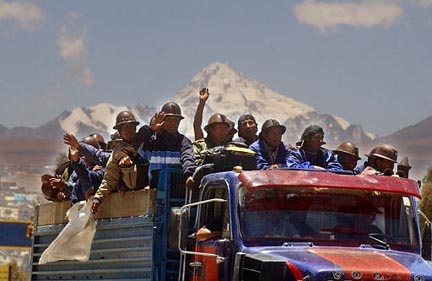
(Photo: Dado Galdieri/AP)
|
With the Miners On the
Road to La Paz
“The most important point is that there is no revolutionary party” The following is the account of a university student from Oruro,
historic center of Bolivia’s mining region, who participated in one of the
marches to La Paz.
We left on a march from Oruro to the city of La Paz. The pro-government forces had put out a series of lies, and they brought their people out to say a lot of things against us. They even had members of the MNR [the Revolutionary Nationalist Movement, party of then-president Sánchez de Lozada], who made a show of crying and saying, “Don’t go on the march, kids.” Despite all of this, we university students went to La Paz. 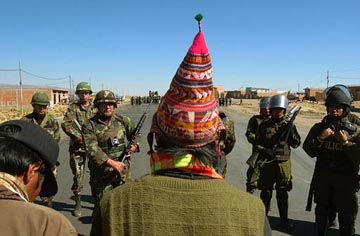 Confrontation between marchers and the army in Patacamaya, October
16.
Confrontation between marchers and the army in Patacamaya, October
16. (Photo: Nacho Calonge/AP) Marching on the highway to La Paz, we went through Patacamaya. There were miners from the Huanuni and Colquiri cooperative mines, as well as members of the retail vendors’ organizations. There were more then five thousand. The day before, the military used a plane to strafe the miners. People were having a wake for three dead miners there. At Patacamaya there were soldiers blocking the miners from continuing on to La Paz. We arrived, there were a thousand or more students from Oruro and we arrived in the afternoon. We were told there were soldiers there and that we could not continue on the road. The next day they let us through, as we saw there were not a lot of them and it would be possible to get past them. From Patacamaya to La Paz we did not encounter any more obstacles. We arrived in La Paz on Friday [October 17], when Sánchez de Lozada had already resigned. A ‘mobilization committee’ met us there. In various places people have chanted ‘Workers to power.’ Even at the most recent assembly of the Oruro COD [the regional labor body affiliated to the COB labor federation], people were yelling the slogan “Workers to power.” But if no clear answer is being given, I think it can all go the wrong way because the bureaucracy and its cliques use two-faced language. There were in this movement, but only to weaken it. In La Paz there were people who did not agree with Carlos Mesa taking over, and who said that things could have gone much further. People in El Alto were quite radical when they received the university students and other sectors, more radical than in La Paz, in fact. So we were met with vivas and chants of ‘Death to Goni.’ All along the road, it was striking to see the solidarity shown by the peasants, by people who are very poor. People will realize that Carlos Mesa represents sectors of the ruling class and that he will not satisfy the demands that have been raised. But if a clear position is not put forward, the opportunists may wind up stronger. The Stalinists, for example, have played a very treacherous role regarding this movement, trying to put the lid on. The most important point is that there is no real leadership, there is no revolutionary party.” |
Versión
en español: Bolivia:
Levantamiento obrero apuñalado
See also: Bolivia Aflame
- Workers to Power
To contact the Internationalist Group and the League for the Fourth International, send e-mail to: internationalistgroup@msn.com